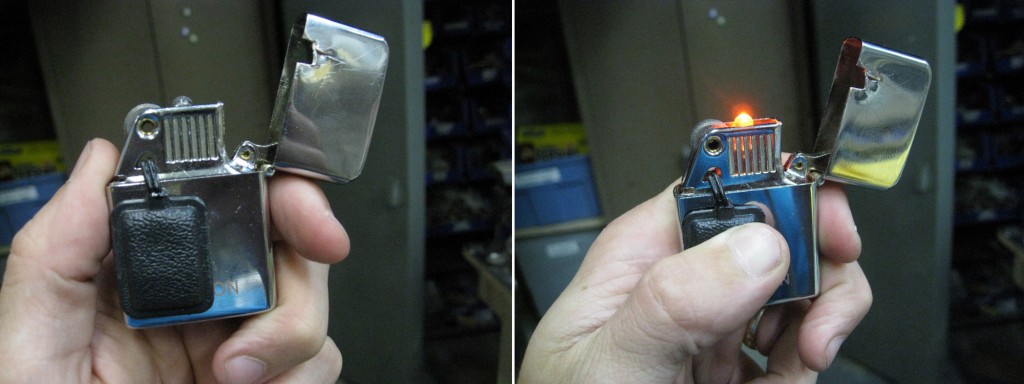Our upcoming production of Capeman wanted a lighter for one of the characters to light a joint. Rather than apply for a live flame permit and fireproof all the costumes, we thought we try to fit an LED into a lighter first. This is my first attempt, so it’s fairly simple, but I learned a lot doing it.

Wiring a single LED is pretty easy; the LEDs we had in the shop required 3 volts of power, so connecting a 3-volt watch battery to it is all it takes to make it light up. You’ll notice one of the wires coming off the LED is longer than the other; on most LEDs, this is the positive side; your LED won’t light up unless you hook the positive wire to the positive side of the battery and vice versa. I used an orange LED to make a color that looked like awesome flames.

I used a Zippo-style lighter. First I gutted the inside and took out all the wadding, wick and flint. If you’re familiar with the Zippo-style lighter, you know you can pull the inside part out of the case. I cut the side away on the inner part so I could access the inside easier; when finished, I could put it back into the outer case and conceal the battery and all the wires.

As I worked on this, I realized one problem; the lighter case was made entirely of metal, and if any of the bare wires made contact, it would keep the light from working. I cut some insulated wire, removed the metal wire from inside, and slid the rubber sleeves onto the wires of the LED. From then on, everything was working properly.

I wired up a switch I found in our box of electronic parts. It was like a pad that would turn the LED on when you squeezed it, and turned it off when you let go.

You’ll notice the switch is on the outside; if held correctly, you can conceal this from the audience. Also, the switch is not connected to the lighter wheel. When lighting it, the actor would need to mime the action of triggering the lighter and time it with pushing the button. As I said in the beginning, this was my first attempt, and it taught me a lot about what I can improve in a future attempt. As is though, it solves the problem in an adequate way. Perfect is good, but done is better.


